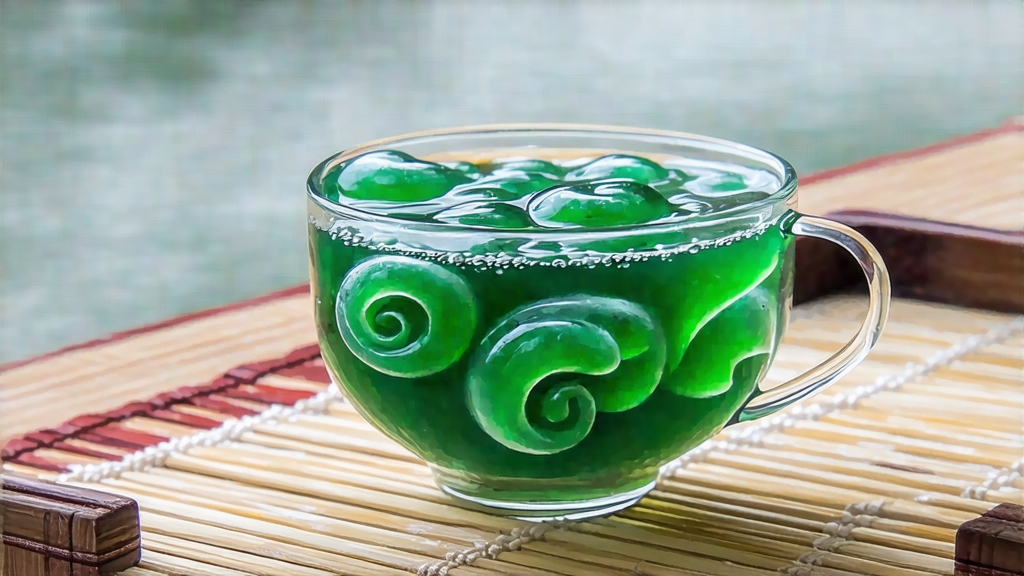
Biluochun, whose name translates literally to “Green Snail Spring,” is one of China’s ten most celebrated teas, yet it remains a quiet marvel outside specialist circles. Grown on the mist-lapped peninsulas of Lake Tai in Jiangsu province, this emerald-green tea is prized for its tiny spiral shape, downy silver tips, and an aroma so fragrant that the Kangxi Emperor (r. 1661-1722) is said to have renamed it “Green of Spring” because its perfume reminded him of the first days of the season. For international drinkers accustomed to the grassy bite of Japanese sencha or the nutty breadth of Longjing, Biluochun offers a softer, more floral path into Chinese green tea.
Historical Roots
Local annals credit a tea-picking nun living on Dongting Mountain for discovering the cultivar during the late Ming dynasty. She noticed that the tender shoots growing wild along the cliff edges exuded an unusually intense scent of apricot blossom and orchid. Monks from nearby temples began to propagate the bushes, and by the early Qing the tea—then called “Xia Sha Ren Xiang,” literally “Scary-fragrant”—was tribute-wheeled to Beijing. When the Kangxi Emperor visited Suzhou in 1699, court scribes record that he rejected the frightening name and bestowed the gentler, now-famous title. European maritime traders first shipped small lots to Amsterdam and London in the 1730s, where it was catalogued as “Pi-lo-chun” and sold at twice the price of Keemun black tea.
Micro-terroir and Cultivars
Lake Tai’s microclimate is the invisible co-author of every cup. The 2,300 km² freshwater lake acts as a thermal regulator, storing daytime heat and releasing it at night, so February nights rarely drop below 5 °C while March afternoons hover at 18 °C. Constant evaporation produces a humid fog that filters sunlight into a soft, diffused glow; chlorophyll develops slowly, amino acids accumulate, and tannic bitterness is kept in check. Two main clonal lines are propagated today: the traditional “Dongting Original” (small leaf, pronounced fruit note) and the later-selected “Wuxi #7” (larger leaf, higher yield, more orchid tone). Both are inter-planted with peach, plum, and loquat trees that attract pollinators and impart additional floral volatiles to the leaf surface.
Harvest Calendar
Authentic Biluochun is picked only once a year, between the Qingming festival (4 April) and Grain Rain (20 April). The plucking standard is draconian: one unopened bud plus the adjacent leaf, 1.5–2.0 cm in total length, must weigh no more than 0.3 g. A skilled picker gathers barely 500 g of fresh leaf in a full dawn-to-lunch shift; 5 kg of raw material are required to yield 1 kg of finished tea. The most coveted grade, “Tou Cai” (first pick), is harvested when 5 % of the garden reaches the target standard, usually on the first three sunny days after Qingming. Any rain during those 72 hours forces a 48-hour pause, because droplets bruise the cell walls and oxidize the edges, flattening the signature aroma.
Crafting the Spiral
Unlike flat-pan Longjing or needle-shaped Liuan Guapian, Biluochun is hand-formed into a tight spiral through a three-step sequence: shaqing (kill-green), rounian (rolling), and tiemao (refine-firing). Sha-qing begins within two hours of plucking. Leaves are tumbled for 3–4 minutes on a drum pan pre-heated to 180 °C; the goal is to deactivate polyphenol oxidase while preserving a 58–60 % moisture content. Immediately afterward the leaves are transferred to a bamboo tray kept at 38 °C where three artisans perform “empty-palm kneading”: the heel of the hand presses the leaf against the tray while fingers curl inward, coaxing the sprig into a snail shell. This motion is repeated 38–42 times over 15 minutes, during which the leaf temperature drops to 30 °C and cellular juices exude, coating the surface with a fragrant film. Finally, the semi-dry curls are given a 20-minute gentle bake at 70 °C to lock in 6–7 % residual moisture. The entire process is completed before sunset of the same day, an urgency that